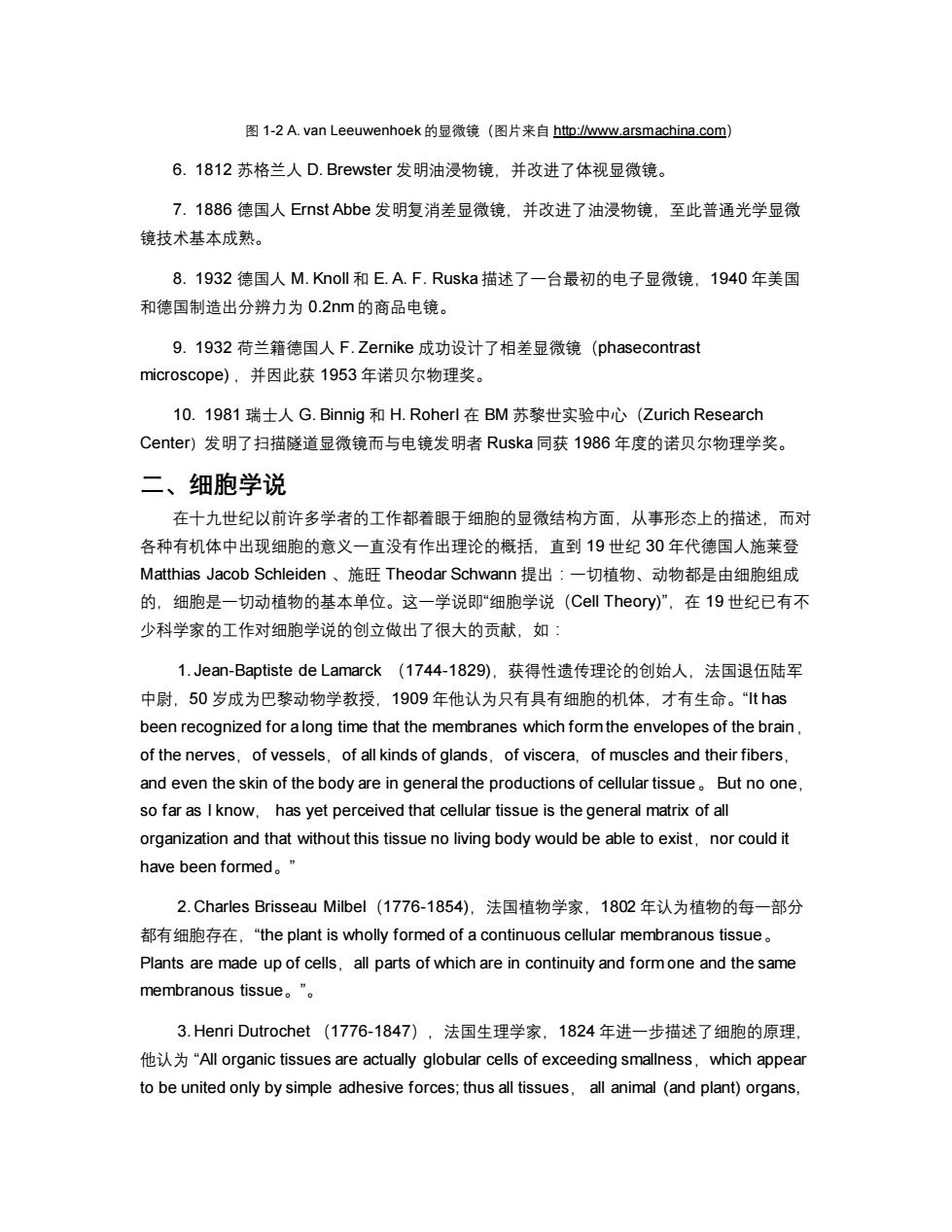正在加载图片...

图1-2A.van Leeuwenhoek的显微镜(图片来自hto:www.arsmachina.com 6.1812苏格兰人D.Brewster发明油浸物镜,并改进了体视显微镜。 7.1886德国人Ernst Abbe发明复消差显微镜,并改进了油浸物镜,至此普通光学显微 镜技术基本成熟。 8.1932德国人M.Knoll和E.A.F.Ruska描述了一台最初的电子显微镜,1940年美国 和德国制造出分辨力为0.2nm的商品电镜。 9.1932荷兰籍德国人F.Zernike成功设计了相差显微镜(phasecontrast microscope),并因此获1953年诺贝尔物理奖。 10.1981瑞士人G.Binnig和H.Roherl在BM苏黎世实验中心(Zurich Research Center)发明了扫描隧道显微镜而与电镜发明者Ruska同获1986年度的诺贝尔物理学奖。 二、细胞学说 在十九世纪以前许多学者的工作都着眼于细胞的显微结构方面,从事形态上的描述,而对 各种有机体中出现细胞的意义一直没有作出理论的概括,直到19世纪30年代德国人施莱登 Matthias Jacob Schleiden、施旺Theodar Schwann提出:一切植物、动物都是由细胞组成 的,细胞是一切动植物的基本单位。这一学说即“细胞学说(Cell Theory)”,在19世纪已有不 少科学家的工作对细胞学说的创立做出了很大的贡献,如: 1.Jean-Baptiste de Lamarck(1744-1829),获得性遗传理论的创始人,法国退伍陆军 中尉,50岁成为巴黎动物学教授,1909年他认为只有具有细胞的机体,才有生命。“1thas been recognized for a long time that the membranes which form the envelopes of the brain, of the nerves,of vessels,of all kinds of glands,of viscera,of muscles and their fibers, and even the skin of the body are in general the productions of cellular tissue.But no one, so far as I know,has yet perceived that cellular tissue is the general matrix of all organization and that without this tissue no living body would be able to exist,nor could it have been formed。" 2.Charles Brisseau Milbel(1776-1854),法国植物学家,1802年认为植物的每一部分 都有细胞存在,“the plant is wholly formed of a continuous cellular membranous tissue。 Plants are made up of cells,all parts of which are in continuity and form one and the same membranous tissue。”。 3.Henri Dutrochet(1776-1847),法国生理学家,1824年进一步描述了细胞的原理, 他认为“All organic tissues are actually globular cells of exceeding smallness,which appear to be united only by simple adhesive forces;thus all tissues,all animal (and plant)organs,图 1-2 A. van Leeuwenhoek 的显微镜(图片来自 http://www.arsmachina.com) 6. 1812 苏格兰人 D. Brewster 发明油浸物镜,并改进了体视显微镜。 7. 1886 德国人 Ernst Abbe 发明复消差显微镜,并改进了油浸物镜,至此普通光学显微 镜技术基本成熟。 8. 1932 德国人 M. Knoll 和 E. A. F. Ruska描述了一台最初的电子显微镜,1940 年美国 和德国制造出分辨力为 0.2nm 的商品电镜。 9. 1932 荷兰籍德国人 F. Zernike 成功设计了相差显微镜(phasecontrast microscope) ,并因此获 1953 年诺贝尔物理奖。 10. 1981 瑞士人 G. Binnig 和 H. RoherI 在 BM 苏黎世实验中心(Zurich Research Center)发明了扫描隧道显微镜而与电镜发明者 Ruska同获 1986 年度的诺贝尔物理学奖。 二、细胞学说 在十九世纪以前许多学者的工作都着眼于细胞的显微结构方面,从事形态上的描述,而对 各种有机体中出现细胞的意义一直没有作出理论的概括,直到 19 世纪 30 年代德国人施莱登 Matthias Jacob Schleiden 、施旺 Theodar Schwann 提出:一切植物、动物都是由细胞组成 的,细胞是一切动植物的基本单位。这一学说即“细胞学说(Cell Theory)”,在 19 世纪已有不 少科学家的工作对细胞学说的创立做出了很大的贡献,如: 1. Jean-Baptiste de Lamarck (1744-1829),获得性遗传理论的创始人,法国退伍陆军 中尉,50 岁成为巴黎动物学教授,1909 年他认为只有具有细胞的机体,才有生命。“It has been recognized for a long time that the membranes which form the envelopes of the brain, of the nerves,of vessels,of all kinds of glands,of viscera,of muscles and their fibers, and even the skin of the body are in general the productions of cellular tissue。 But no one, so far as I know, has yet perceived that cellular tissue is the general matrix of all organization and that without this tissue no living body would be able to exist,nor could it have been formed。” 2. Charles Brisseau Milbel(1776-1854),法国植物学家,1802 年认为植物的每一部分 都有细胞存在,“the plant is wholly formed of a continuous cellular membranous tissue。 Plants are made up of cells,all parts of which are in continuity and form one and the same membranous tissue。”。 3. Henri Dutrochet (1776-1847),法国生理学家,1824 年进一步描述了细胞的原理, 他认为 “All organic tissues are actually globular cells of exceeding smallness,which appear to be united only by simple adhesive forces; thus all tissues, all animal (and plant) organs